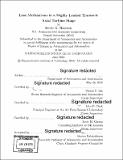Loss mechanisms in a highly loaded transonic axial turbine stage
Author(s)
Shannon, Kevin R. (Kevin Robert)
DownloadFull printable version (17.86Mb)
Other Contributors
Massachusetts Institute of Technology. Department of Aeronautics and Astronautics.
Advisor
Choon S. Tan, John P. Clark and Scott M. Carson.
Terms of use
Metadata
Show full item recordAbstract
Flow in a one-and-a-half stage highly loaded transonic axial turbine representative of future generation turbine technology is assessed for its role in loss generation. Steady and unsteady two-dimensional and three-dimensional flow computations, complemented by simplistic control volume analyses as well as test data, provided results for establishing the quantitative level of loss from various sources. The test data has been acquired in a cascade and blowdown turbine research rig. Specifically, the overall loss determined from unsteady three-dimensional flow computations of a cooled one-and-a-half stage turbine is within 6% of that inferred from the blowdown turbine rig test data. The computed flows with different levels of flow and configuration complexities are post-processed and interrogated to allow an estimation of blade profile loss, trailing edge loss, shock loss, endwall loss, secondary flow loss, tip leakage loss, cooling injection loss, and unsteady flow loss. The dominant sources of loss are determined to be the trailing edge loss, profile loss, and tip leakage loss. The computed flows show that the flow deviation in a highly loaded transonic turbine airfoil with trailing edge shocks is negative (-2° to -4°); estimating the trailing edge loss by assuming zero flow deviation in a simple control volume approach would yield a significantly higher value. Loss arising from flow unsteadiness contributes an additional loss of about 1/6 of that in steady flow approximation; 3/4 of the flow unsteadiness induced loss occurs in the downstream vane where the flow is threaded with propagating shocks from the upstream blade and downstream shock reflections; and the remaining 1/4 is from unsteadiness in NGV wakes and shock oscillations from influence of the adjacent airfoil row. 1/5 of the overall loss in the one-and-a-half stage turbine is from the cooling and purge flows. A preliminary assessment of loss variation with turbine stage pressure ratio shows a non-monotonic trend.
Description
Thesis: S.M., Massachusetts Institute of Technology, Department of Aeronautics and Astronautics, 2018. Cataloged from PDF version of thesis. Includes bibliographical references (pages 129-130).
Date issued
2018Department
Massachusetts Institute of Technology. Department of Aeronautics and AstronauticsPublisher
Massachusetts Institute of Technology
Keywords
Aeronautics and Astronautics.